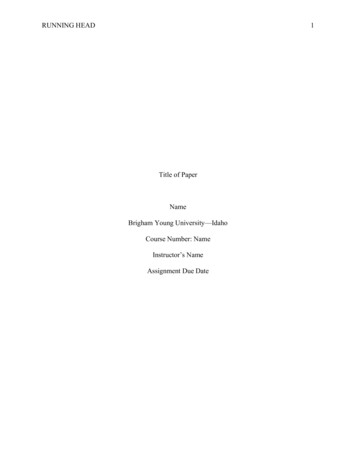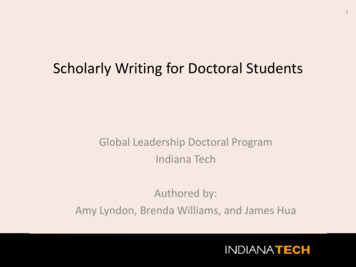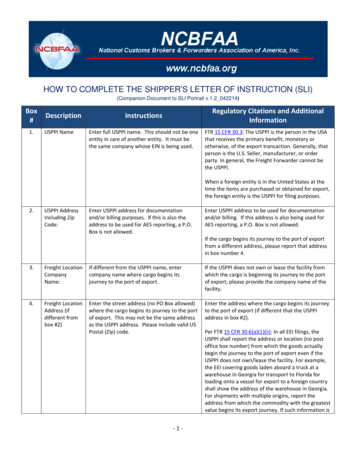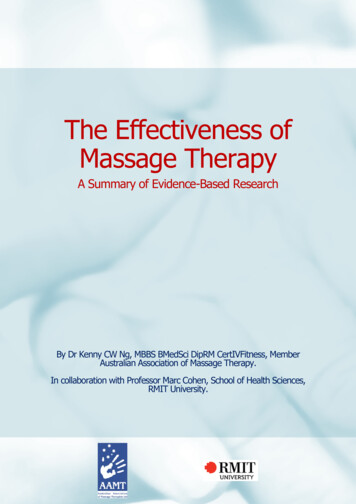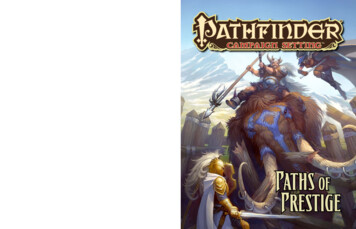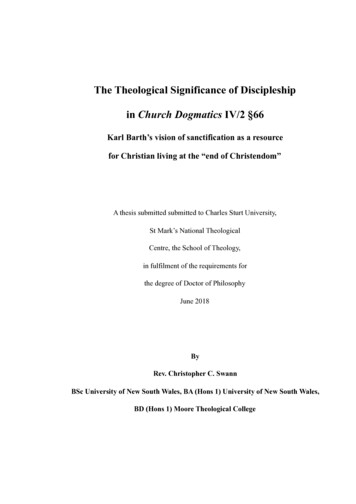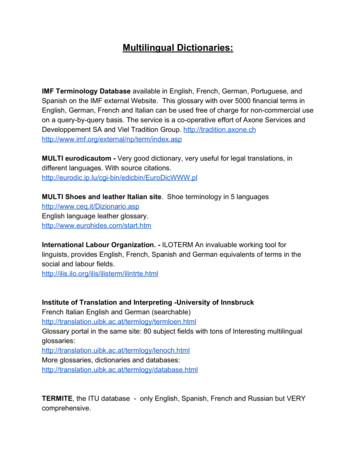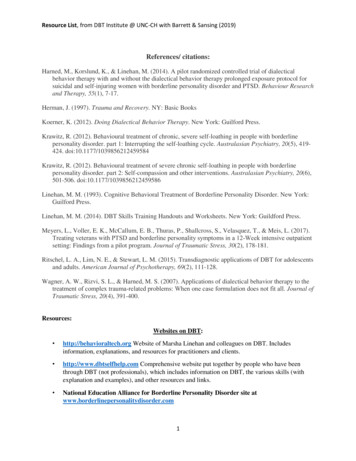
Transcription
Resource List, from DBT Institute @ UNC-CH with Barrett & Sansing (2019)References/ citations:Harned, M., Korslund, K., & Linehan, M. (2014). A pilot randomized controlled trial of dialecticalbehavior therapy with and without the dialectical behavior therapy prolonged exposure protocol forsuicidal and self-injuring women with borderline personality disorder and PTSD. Behaviour Researchand Therapy, 55(1), 7-17.Herman, J. (1997). Trauma and Recovery. NY: Basic BooksKoerner, K. (2012). Doing Dialectical Behavior Therapy. New York: Guilford Press.Krawitz, R. (2012). Behavioural treatment of chronic, severe self-loathing in people with borderlinepersonality disorder. part 1: Interrupting the self-loathing cycle. Australasian Psychiatry, 20(5), 419424. doi:10.1177/1039856212459584Krawitz, R. (2012). Behavioural treatment of severe chronic self-loathing in people with borderlinepersonality disorder. part 2: Self-compassion and other interventions. Australasian Psychiatry, 20(6),501-506. doi:10.1177/1039856212459586Linehan, M. M. (1993). Cognitive Behavioral Treatment of Borderline Personality Disorder. New York:Guilford Press.Linehan, M. M. (2014). DBT Skills Training Handouts and Worksheets. New York: Guildford Press.Meyers, L., Voller, E. K., McCallum, E. B., Thuras, P., Shallcross, S., Velasquez, T., & Meis, L. (2017).Treating veterans with PTSD and borderline personality symptoms in a 12‐Week intensive outpatientsetting: Findings from a pilot program. Journal of Traumatic Stress, 30(2), 178-181.Ritschel, L. A., Lim, N. E., & Stewart, L. M. (2015). Transdiagnostic applications of DBT for adolescentsand adults. American Journal of Psychotherapy, 69(2), 111-128.Wagner, A. W., Rizvi, S. L., & Harned, M. S. (2007). Applications of dialectical behavior therapy to thetreatment of complex trauma‐related problems: When one case formulation does not fit all. Journal ofTraumatic Stress, 20(4), 391-400.Resources:Websites on DBT: http://behavioraltech.org Website of Marsha Linehan and colleagues on DBT. Includesinformation, explanations, and resources for practitioners and clients. http://www.dbtselfhelp.com Comprehensive website put together by people who have beenthrough DBT (not professionals), which includes information on DBT, the various skills (withexplanation and examples), and other resources and links. National Education Alliance for Borderline Personality Disorder site atwww.borderlinepersonalitydisorder.com1
Resource List, from DBT Institute @ UNC-CH with Barrett & Sansing (2019) Valerie Porr's TARA site at www.tara4bpd.org (Treatment and Research AdvancementsAssociation for Personality Disorder) provides information for friends and family members. Borderline Personality Disorder - Family Connections y-connections.shtml has audio recording of PerryHoffman, PhD on difficulties with family members (15-20 minutes)DBT Texts Linehan, Marsha (1993). Cognitive Behavioral Treatment of Borderline Personality Disorder. NewYork: Guilford Press. This is the original textbook (DBT “Bible”) where Linehan fleshes out DBTfor therapists. Dense and informative, an absolute must-have for any therapist doing DBT or forpatients who want to know what to expect. Koerner, Kelly (2011). Doing Dialectical Behavior Therapy: A Practical Guide. New York:Guilford Press. Engaging book that describes in detail how to practice DBT. It is clearly written,with lots of helpful examples (including the case example from today’s training). Dimeff, Linda A., Koerner, Kelly, and Linehan, Marsha (2007). Dialectical Behavior Therapy inClinical Practice: Applications across Disorders and Settings. New York: Guilford Press. Eachchapter applies DBT to a different problem, such as depression, substance dependence, eatingdisorders, psychosis, suicidal and assaultive behavior, or other complex problems, with practicaladvice for day-to-day issues facing DBT practitioners. Fruzzetti, Alan E. and Linehan, Marsha M. (2006). The High Conflict Couple: A DialecticalBehavior Therapy Guide to Finding Peace, Intimacy, & Validation. Oakland, CA: NewHarbinger Publications. This book is full of practical tips and exercises on how to enhancerelationships. Central to the approach is validation (what it is, how to do it, and how often peopleinadvertently invalidate each other without realizing it). Miller, Alec L., Rathus, Jill H., and Linehan, Marsha (2007). Dialectical Behavior Therapy withSuicidal Adolescents. New York: Guilford Press. For clinicians. Very clearly written, providesinsights into developmental-systemic process relevant to adults coping with severe emotionaldysregulation. Swenson, C. (2018). DBT Principles in Action: Acceptance, Change, and Dialectics. New York:Guilford Press. Master DBT clinician Charlie Swenson provides guidance for DBT cliniciansthrough examples, stories, and clarifying concept and strategies.Practice Manuals Linehan, Marsha M. (2015a). DBT Skills Training Manual, 2nd ed. New York: Guilford Press.This is the book for clinicians who are co-leading DBT skills groups. It includes the rationale,structure, strategies, and teaching notes for each of four skills modules. It is companion for manualbelow. Linehan, Marsha M. (2015b). DBT Skills Training Handouts and Worksheets, 2nd ed. New York:Guilford Press.Revised, updated, and reformatted skills manual for therapist and patient. If purchased throughGuilford Press, you can download unlimited copies of handouts and worksheets.2
Resource List, from DBT Institute @ UNC-CH with Barrett & Sansing (2019) McKay, Matthew, Wood, Jeffrey, and Brantley, Jeffrey (2007). Dialectical Behavior Therapy SkillsWorkbook: Practical DBT Exercises for Learning Mindfulness, Interpersonal Effectiveness,Emotion Regulation, & Distress Tolerance. Oakland, CA: New Harbinger PublicationsThis workbook gives step-by-step exercises, with examples, to learn DBT concepts and practiceexercises to manage emotions. User-friendly.On Mindfulness and Acceptance Brantley, Jeffrey (2007). Calming Your Anxious Mind: How Mindfulness and Compassion CanFree You from Anxiety, Fear, and Panic. Oakland, CA: New Harbinger Publications. Instructsreaders on the role that thoughts and emotions play in anxiety, and provides a step-by-step guideto developing mindfulness practices, which include presence, stillness, and loving kindness,which can enable them to feel safe while opening up to fearful feelings. Germer, C. K. (2009). The Mindful Path to Self-Compassion: Freeing Yourself from DestructiveThoughts and Emotions. New York: Guilford Press. Written in warm, gentle, down-to-earthstyle, Chris Germer provides clear argument and practical tips for cultivating a compassionatemeditation practice. Hahn, Thich Nhat (1999). The Miracle of Mindfulness. Boston, MA: Beacon Press. Worldrenowned Vietnamese Buddhist monk and Zen master Thich Nhat Hanh weaves practicalinstruction with anecdotes and other stories to show how the meditative mind can be achieved atall times and how it can help us heal. Hahn is a prolific writer on mindfulness, and this is one ofhis most popular books. Some others include: The Art of Mindful Living; Mindfulness forPsychotherapists (audiotape); and Living Buddha Living Christ (which can serve as bridge forsome who are uncomfortable with idea of Buddhism). Horstead, Sharon (2010). Living the Mindful Way: 85 Everyday Mindfulness Practices ForFinding Inner Peace. Mindful Heart Learning Press. This book offers mindfulness practices tofind joy inside and around you, your strength to progress, your core purpose, your courage, andinner peace. Kabat-Zinn, Jon (1995). Wherever You Go, There You Are. New York: Hyperion Books. Blendsstories, anecdotes, poems, images, and scientific observations with easily followed instructions inthe art of "capturing" the present and living fully within each moment in order to achieve innerpeace. Jon Kabat-Zinn is the creator of Mindfulness-based Stress Reduction programs, andcredited with bringing mindfulness into mainstream in the West. Some of his other books include:Full Catastrophe Living: Using the Wisdom of your Body and Mind to Face Stress, Pain, andIllness (1990); and Mindfulness for Beginners: Reclaiming the Present Moment—and yourLife (2011). Williams, Mark, Teasdale, John D., Segal, Zindel V., and Kabat-Zinn, Jon (2007). The MindfulWay through Depression: Freeing Yourself from Chronic Unhappiness. New York: GuilfordPress. Uses mindfulness to help people attend to their emotions and sidestep mental habits thatcan lead to despair, rumination, and self-blame. Accompanying CD with guided meditations byJon Kabat-Zinn.3
Resource List, from DBT Institute @ UNC-CH with Barrett & Sansing (2019)On Borderline Personality Disorder Manning, S. Y. (2011). Loving Someone with Borderline Personality Disorder: How to KeepOut-of-control Emotions from Destroying Your Relationship. New York: Guilford Press. Nonpathologizing, helpful guide for individuals in relationship with someone with BPD. Author ShariManning studied with Marsha Linehan. Chapman, Alex, and Gratz, Kim (2007). The Borderline Personality Disorder Survival Guide.Oakland, CA: New Harbinger Press. Road map to guide people through BPD and itstreatment, including DBT, mentalization-based therapy, and medication. Hoffman, Perry and Gunderson, John (editors) (2005). Understanding and Treating BorderlinePersonality Disorder: A Guide for Professionals and Families. Washington, DC: AmericanPsychiatric Association. Anthology of chapters by 15 experts on variety of topics, including theetiology of BPD and effectiveness of DBT in reducing self-injury and drug dependence. Containsresources for families with a member who suffers from BPD, and how to build partnerships withmental health professionals. Lawson, Christine (2002). Understanding the Borderline Mother: Helping Her ChildrenTranscend the Intense, Unpredictable, and Volatile Relationships. Jason Aronson, Inc. Forindividuals who were raised by a mother with BPD, this is considered a very helpful resource,readable and validating. Manning, Shari Y. (2011). Loving Someone with Borderline Personality Disorder: How to KeepOut-of-Control Emotions from Destroying Your Relationship. New York: Guilford Press.Helps overwhelmed loved ones understand why their spouses, adult children, or other familymembers act the way they do and how to respond constructively. Practical, clear, kind. Porr, Valerie (2010) Overcoming Borderline Personality Disorder: A Family Guide for Healingand Change. Oxford University Press. Compassionate and informative guide to help familiesunderstand BPD (as a neurobiological disorder), which also provides skills to cope, which aredrawn from DBT and mentalization-based therapy (Peter Fonagy’s work). Van Gelder, Kiera (2010). The Buddha & the Borderline: My Recovery from BorderlinePersonality Disorder through Dialectical Behavior Therapy, Buddhism & Online Dating.Oakland, CA: New Harbinger Publications. Well written memoir of a young woman contendingwith BPD, treatment, and healing. Website: www.buddhaandborderline.com (contains video fromtoday’s training).Local DBT Resources Triangle Area DBT (TADBiT): founded by Meggan Moorhead and Norma Safransky topromote the use of DBT in the Triangle Area http://www.triangleareadbt.com Currently run byEric Gadol and Martha Golden. TADBiT has been expanding to serve greater North Carolina. DBT Listserv: DBT individual and/or group therapists in the NC community.4
Resource List, from DBT Institute @ UNC-CH with Barrett & Sansing (2019) DBT-U for university students: https://www.dbt-u.com/. Groups run by semester schedule inChapel Hill, Carrboro, Durham, Raleigh5
A pilot randomized controlled trial of dialectical behavior therapy with and without the dialectical behavior therapy prolonged exposure protocol for suicidal and self-injuring women with borderline personality disorder and PTSD. Behaviour Research and Therapy, 55(1), 7-17. Herman, J. (1997). Trauma and Recov
